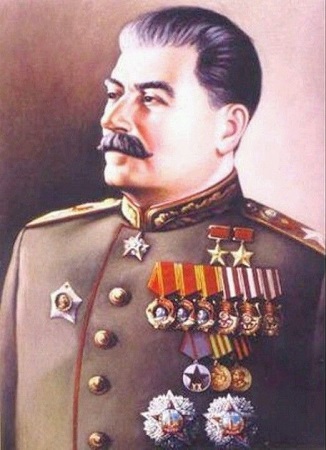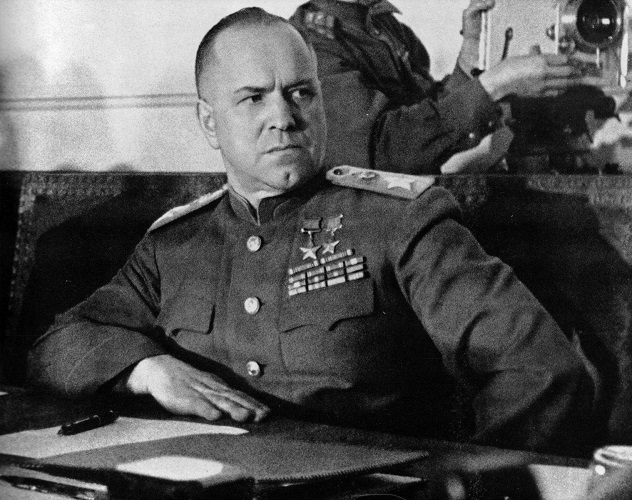● ● ●
On 22 June 1941—the first day day
of World War II for the USSR—the country’s highest military
organ was the Defense Committee of the Council of People’s
Commissars. Immediately under the Defense Committee were the
People’s Commissariat of Defense (for the Army) and the
People’s Commissariat of the Navy. Within the Defense
Commissariat, the principal decision-making body was the
Main Military Council. Command of the Red Army rested with
the People's Commissar of Defense, whose executive agent was
the Chief of the General Staff. Stalin himself, who in May
1941 had assumed the position of chairman of the Council of
People’s Commissars (prime minister) had not yet established
a formal relationship with the armed forces. In the field,
the highest-ranking commands were the sixteen Military
Districts into which the USSR was divided, plus the Far
Eastern Front (army group).
In the event of war, it was
intended to create a war cabinet to direct policy and
strategy at the highest level, and a supreme military
headquarters to plan and direct military operations. Neither
of these bodies existed on 22 June 1941, however. The war
plan also envisioned the conversion of the five western
military districts into operational front (army group)
commands.
The military command structure was
paralleled by the military commissar system, whose task was
to exercise political oversight and control of the Army. The
commissar system had originated during the Civil War and
after being abolished for a time it was reinstituted in
1937, during the military purge that decimated the officer
corps. By 1941 the military commissars, now called deputy
commanders for political affairs, were ubiquitous, being
assigned down to the regimental level. In July 1941 these
political officers were given formal authority to review and
revoke commanders’ orders, and in addition so-called
political leadership officers were assigned down to the
platoon level. At high levels of command political officers
were usually senior party officials. Nikita Khrushchev, for
example, served on the Military Council of Stalingrad Front
as the Party’s representative. Perforce, commanders had to
be granted more latitude in the conduct of operations in
wartime, but political supervision of the Red Army remained
a priority for Stalin and his cronies. The whole system was
run by Main Political Administration of the Army,
responsible for the political supervision of every commander
and the political indoctrination of the troops. The
commissar system was supplemented by the all-powerful
political police, the NKVD, which maintained a Special
Section for Military Affairs.
On 23 June 1941 the Main Military
Council became the Stavka (general headquarters) of the High
Command. Its principal members were Marshal of the Soviet
Union S.K. Timoshenko (Chairman), Marshal of the Soviet
Union K.Y. Voroshilov (Chairman of the Defense Committee)
General of Army G.K. Zhukov (Chief of the General Staff),
Fleet Admiral N.K. Kuznetsov (People’s Commissar of the
Navy), Marshal of the Soviet Union Semyon Budyonny, V.M.
Molotov and Stalin (members). In July, when Stalin assumed
the title of Supreme Commander (Generalissimus), it
became the Stavka of the Supreme Command, and in August it
was retitled the Stavka of the Supreme High Command, with
authority over all the armed forces of the state. Within
Stavka the General Staff of the Red Army was the main
military planning agency. The General Staff was also
responsible for doctrinal matters: the organization of
military formations and their tactical/operational
employment.

The Generalissimus:
Stalin as Supreme Commander. An idealized portrait by a
Soviet artist.
On 30 June 1941, Stalin established
the State Defense Committee (GKO), with himself as chairman.
The GKO had supreme authority over all political, economic,
and military policy. This centralization of war powers was
in sharp contrast to the situation on the German side, where
competing fiefdoms—the Party, the SS, the armed
forces—engaged in a constant struggle for authority and
resources, greatly to the detriment of the war effort.
It need hardly be said that
whatever the details of Stavka’s organizational template,
the authority of Stalin was paramount. His assumption of the
position of Generalissimus merely formalized a
preexisting situation. Early in the war his influence on
military matters was frequently counterproductive—as when he
refused to sanction the timely abandonment of Kiev in
September 1941, a mistake that led to the loss of some
700,000 men. But unlike Hitler, Stalin learned from his
mistakes and on the whole he proved to be a far more
effective supreme commander than the German leader.
During most of the war the highest
level of command in the field was the front (army group).
Fronts were quite variable in size, ranging from three
armies to as many as nine. In 1943 infantry armies typically
embodied between six and twelve rifle
divisions; the average was
eight. If earmarked to participate in a major offensive, an
army was heavily reinforced with tank, artillery, rocket
artillery and self-propelled artillery (armored assault gun)
units. Sometimes a full
tank corps was attached. Shock
armies were similar to infantry armies but with more
artillery and a higher level of mechanization. Tank armies
usually had two tank corps and a mechanized corps and they
too were reinforced with additional units as required.
Generally, Red Army units were smaller than German or
Western Allied ones with the same designations. Tank
brigades were really battalions, tank and mechanized corps
were really divisions, the chronically understrength rifle
divisions were usually the size of brigades. Until late in
the war the Soviet front was smaller than the German army
group, two or three of the former, usually, being equivalent
to one of the latter.

Marshal of the Soviet
Union G.K. Zhukov officiates at the formal surrender of
Germany, Berlin, 9 May 1945 (Red Army)
Major operations involving more
than one front were coordinated on Stalin’s behalf by Stavka
representatives, Zhukov often serving as such. This was an
informal arrangement but it worked well once Stalin learned
to listen to his senior military commanders—this in sharp
contrast to the situation on the German side, where Hitler’s
longstanding distrust of his generals gradually developed
into a mania. To be sure, the war opened disastrously for
the USSR and many unsuccessful commanders found themselves
facing an NKVD firing squad. But eventually there was
developed a body of competent, war-experienced senior
officers, and though it would be going too far to say that
Stalin trusted his generals he and they managed to forge an
effective partnership.
The efficiency of its high command
was a major factor in the USSR’s victory over Nazi Germany.
Stavka, and the GKO above it, provided the armed forces in
the field with clear direction, establishing strategic
priorities and allocating resources in a manner that the
enemy’s fragmented command structure could not match.
● ● ●